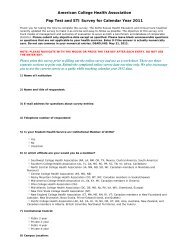Primary Prevention of Sexual Violence - American College Health ...
Primary Prevention of Sexual Violence - American College Health ...
Primary Prevention of Sexual Violence - American College Health ...
- No tags were found...
You also want an ePaper? Increase the reach of your titles
YUMPU automatically turns print PDFs into web optimized ePapers that Google loves.
Purpose <strong>of</strong> the ToolkitThe purpose <strong>of</strong> this toolkit — Shifting the Paradigm: <strong>Primary</strong><strong>Prevention</strong> <strong>of</strong> <strong>Sexual</strong> <strong>Violence</strong> — is to provide facts, ideas,strategies, conversation starters, and resources to everyone oncampus who cares about the prevention <strong>of</strong> sexual violence.Whether you are a faculty or staff member or an administratoror student, there are resources included that are directly relevantto your role in the campus community. Please take a moment tolook through these materials and decide how you can bestutilize this toolkit as an individual, in your center/<strong>of</strong>fice, department,or at the overall institution level. If you are tempted tosimply pass this toolkit <strong>of</strong>f to the person or <strong>of</strong>fice that deals withsexual assault, consider this — the only way to prevent sexualviolence and promote a culture <strong>of</strong> caring is for the entirecampus community to focus on this campus concern.All <strong>American</strong> <strong>College</strong> <strong>Health</strong> Association (ACHA) membershave been sent this toolkit and we are asking that you disseminatethis resource across your campus. You may either copyall <strong>of</strong> it or portions <strong>of</strong> it or download it at www.acha.org/<strong>Sexual</strong><strong>Violence</strong>. Likewise, you may choose to electronically sendthe toolkit to key stakeholders at your institution. As you reviewthe toolkit, we ask that you consider:✤ Organizing a meeting <strong>of</strong> key leaders to discuss how todisseminate (See “Key Partnerships in <strong>Sexual</strong> <strong>Violence</strong><strong>Prevention</strong>” and “Spread the Word”) and utilize the toolkitfor your campus community. Be sure to include representativesfrom the president/chancellor's <strong>of</strong>fice, faculty, healthcenter, counseling center, health promotion, women’scenter/studies, Panhellenic/Interfraternity Councils, athletics,dean <strong>of</strong> students, student affairs, peer educators, andother interested parties.✤ Encouraging your student health/counseling/health promotionstaff to review this toolkit and discuss how to incorporatethe “Screening for <strong>Sexual</strong> <strong>Violence</strong>” tools into your interactionswith students and “Opportunities for <strong>Prevention</strong>Messages during Campus <strong>Health</strong> Visits.”✤ Distributing the ACHA Guidelines: Position Statementon Preventing <strong>Sexual</strong> <strong>Violence</strong> on <strong>College</strong> and UniversityCampuses to all college health pr<strong>of</strong>essionals andother key people. Likewise, use the “Position StatementAssessment Tool” to guide your campus efforts atpreventing sexual violence.✤ Distributing the handout “10 Ways Young Men Can Prevent<strong>Sexual</strong> <strong>Violence</strong>” to male students and discussing these pointswith them.✤ Initiating or facilitating roundtable discussions, events,trainings, and/or workshops on:• How your campus can embrace the shifting paradigmconcept <strong>of</strong> primary prevention <strong>of</strong> sexual violence (See“<strong>Sexual</strong> <strong>Violence</strong> <strong>Prevention</strong>”)• How your campus can address the connection betweenoppression and violence (See “Re-visioning the <strong>Sexual</strong><strong>Violence</strong> Continuum”)• How to analyze your campus culture and the social normsregarding alcohol, sexual behavior, and sexual violence(See “Alcohol and <strong>Sexual</strong> <strong>Violence</strong>”)• How your campus can address the specific needs <strong>of</strong>international students, LGBT students, and cultural diversitygroups regarding this topic• How to develop bystander intervention strategies (See“Preventing <strong>Sexual</strong> <strong>Violence</strong> through Empowering CampusBystanders”)• How to promote a culture <strong>of</strong> caring and sexual ethics onyour campus• How to gain consent for all sexual activities andencounters (See “Importance <strong>of</strong> Consent”)• How to address gender roles, gender inequality, and malepeer support for sexual aggression• How protective factors in your particular campus culturecan be strengthened✤ Encouraging student organizations, fraternities, sororities,campus activities, student government, and others to bringin national speakers on sexual violence prevention.✤ Discussing the best strategy for enlisting buy-in and endorsementfrom the president or chancellor <strong>of</strong> your institution.✤ Utilizing this toolkit in programming for <strong>Sexual</strong> AssaultAwareness Month (SAAM) each April.✤ Adapting any <strong>of</strong> the materials or tools to fit your uniquecampus needs and change them to fit your campus cultureLastly, talk about this issue! The health and academic success<strong>of</strong> our students will only be enhanced once there is a commitmentto address sexual violence on campus. Good luck to you all.4



![Final Program [5.4MB pdf] - American College Health Association](https://img.yumpu.com/49022356/1/190x245/final-program-54mb-pdf-american-college-health-association.jpg?quality=85)












